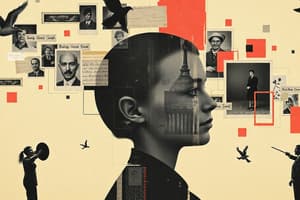Podcast
Questions and Answers
What is communication?
What is communication?
The transmission of ideas and emotions between or among people, using both verbal and nonverbal cues.
Who is the sender in a communication process?
Who is the sender in a communication process?
The person who encodes the message.
What is feedback in communication?
What is feedback in communication?
Message/comments from the receiver.
Which of the following are types of communication? (Select all that apply)
Which of the following are types of communication? (Select all that apply)
What is proxemics?
What is proxemics?
Define kinesics.
Define kinesics.
What does chronemics refer to?
What does chronemics refer to?
Which of the following is a model of communication?
Which of the following is a model of communication?
What is intercultural communication?
What is intercultural communication?
Which of the following can be considered barriers to communication? (Select all that apply)
Which of the following can be considered barriers to communication? (Select all that apply)
What is the difference between ascribed and achieved social class?
What is the difference between ascribed and achieved social class?
Flashcards are hidden until you start studying
Study Notes
Communication Basics
- Communication is the transfer of thoughts and emotions using verbal and nonverbal cues between individuals.
- Sender encodes the message, while the receiver decodes it.
- Feedback allows the receiver to provide input to the sender.
- Verbal communication uses spoken words to convey messages.
- Nonverbal communication utilizes body language, gestures, and other nonverbal cues to communicate.
Understanding Context
- Culture shapes communication through its unique norms and values.
- Proxemics relates to the space between communicators.
- Kinesics refers to body language.
- Chronemics examines how time influences communication.
- Haptics explores the use of touch in communication.
- Paralanguage focuses on the tone, speed, and volume of a speaker's voice.
Communication Models
- Linear Model is a one-way communication process where information flows from sender to receiver.
- Interactive Model involves two-way communication where feedback is exchanged.
- Transactional Model emphasizes simultaneous communication with mutual influence.
Factors Affecting Communication
- Intercultural communication examines communication between people from different cultures.
- Self-awareness is crucial for effective communication, especially with individuals from different backgrounds.
- Gender influences communication styles, with potential differences between men and women.
- Age can also affect communication due to varying life experiences and perspectives.
Social Status
- Social status reflects an individual's position in society.
- Ascribed social class is determined at birth based on factors like age, sex, race, and family background.
- Achieved social class is attained through personal achievements like education, occupation, and skills..
Barriers to Communication
- Language barriers can arise from differences in languages, accents, unfamiliar words, technical jargon, or idioms.
- Cultural barriers stem from misinterpretations due to differing cultural norms, values, beliefs, or insensitivity to other cultures.
- Physical barriers are obstacles caused by environmental factors, such as noise, poor lighting, or distance between speaker and listener.
Studying That Suits You
Use AI to generate personalized quizzes and flashcards to suit your learning preferences.




